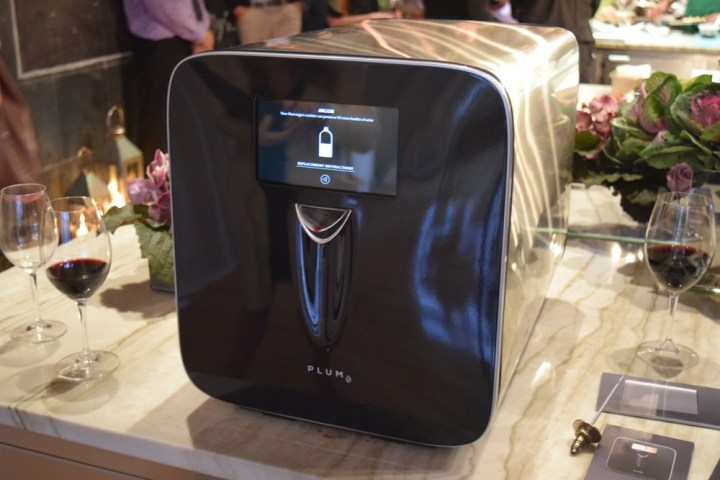
The eponymous Plum dispenser is not your average wine accessory. The brainchild of David Koretz, a former security analyst turned entrepreneur, it is a system that not only pours wine precisely by the glass, but one that fits aesthetically alongside high-end kitchen appliances, services wine at its optimal temperature, and ensures the integrity of that wine for weeks on end.

It all starts with the bottle in question. Place a standard 750ml bottle of wine in one of the Plum’s two receptacles and a pair of cameras within the appliance automatically identifies it from a database of more than 6 million labels by vintage, region, variety, and winery, and calibrates the internal temperature to the climatic conditions suggested — in many cases of the vineyards responsible. Climate control is handled by two thermoelectric, solid-state cooling units that chill continuously, and the algorithms crunched by a powerful 64-bit quad-core processor.
When it comes time to pour, the Plum’s other core component springs into action: a tiny, double-cored motorized injection needle that punctures the cork, composite, or any other cap material with surprising force. Once said bottle top has been punctured, the needle depressurizes the bottle’s insides with a small infusion of argon gas from a replaceable canister. That, in turn, forces the wine through a series of stainless-steel tubing and ultimately through a spout. Once the desired amount of wine is poured, the gas stops flowing and the bottle effectively reseals.

The details of each step are made available for perusal on the Plum’s panel, a 7-inch, full-color HD IPS touchscreen. The loaded wine’s label displays prominently in the center — or, if two bottles are loaded, alongside another — and, if tap, show the wine’s region of origin, a brief history, and even recent reviews. It is all delivered over the internet over Wi-Fi or Ethernet, Koretz said and therefore dynamic. “It can be updated over time,” he said.
The Plum’s display also as a window into its other machinations. You can manually change the temperature settings, for instance, either by fractions of degrees or type of wine — 54 degrees for a Chardonnay, for instance, or 65 degrees for a Cabernet Sauvignon. You can increase or decrease the Plum’s standard pour size. You can monitor the Plum’s level of argon, down to the number of bottles it can preserve before it will need to be replaced. And you can browse a history of the wines you have had, or even follow the tasting habits of other Plum users, sommeliers, and winemakers.
The Plum packs a veritable bundle of technology besides. It has Bluetooth, a proximity sensor, and an integrated speaker. But Koretz’s hope is that the appliance’s technology blends into the background. He envisions the Plum as a means of enjoying wine casually, at home, without the hassle, worry, or guilt associated with enjoying a single pour. “I was hugely frustrated with how disconnected the wine bottle was with how I live my life. I don’t spend every evening dining at restaurants and popping corks,” he said. “Like most people I’m at home, sitting at the kitchen counter, replying to emails and I just want a glass of wine, not the whole bottle, and I want it to be the proper temperature.”
The Plum team spent more than two years engineering the current solution. They tested a variety of tubing materials before settling on stainless steel — “medical tubing oxidizes a wine in two weeks … [while] stainless steel keeps it perfect for 90 days,” said Koretz — and spent months refining the Plum’s software. The UV-coated, brushed steel outer shell, interestingly, was one of the most challenging elements — the Plum team had to recruit an auto-parts maker to produce the Plum’s arresting outer curve. “Every other firm we approached told us a single, seamless curve of that precision was impossible,” he said. “That just speaks to our obsessive side.”

In keeping with the Plum’s mission of worry-free functionality, it is relatively free of maintenance. The Plum’s argon canister holds more than 200 bottles worth of preservation, Koretz said, and only needs to be changed about every 18 months.
But all that convenience does not come cheap. The Plum starts at $1,500, a price which Koretz argues is “fair” given the Plum’s value proposition: the pricier the pour and more extensive the collection, he argues, the more useful the Plum becomes. “Most people have a special bottle of wine that never gets opened because they’re worried they’ll waste it,” he said. “With a Plum, you’ll never again entertain the thought of pouring an expensive wine down the drain.”
The Plum is available for pre-order at its website and begins shipping later in 2016.


